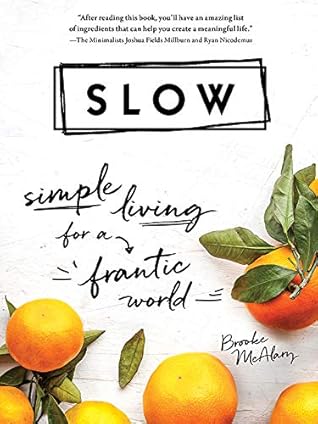More on this book
Kindle Notes & Highlights
Slow living is a curious mix of being prepared and being prepared to let go.
Start with Why
“We are what we repeatedly do,”
There was an enormous disconnect between the things I valued most and my everyday actions.
“Write your eulogy in three sentences,”
What kind of a life would I need to live in order for people to say the things I wanted them to say about me?
“Am I living a life right now that would look like that if we were to fast-forward about fifty years?”
we are what we repeatedly do.
we need to work out our own priorities and go from there.
In order to change, we first need to notice.
To notice what gives us passion and energy, what lights us up and makes us feel good.
paying attention to the inputs in my life
The Icarus Deception by Seth Godin
“Fossils and Tin” by Shred Kelly
The Little Prince by Antoine de Saint-Exupéry
The Wool Trilogy by H...
This highlight has been truncated due to consecutive passage length restrictions.
Bronnie Ware’s “Regrets of the Dyi...
This highlight has been truncated due to consecutive passage length restrictions.
Stephen King’s On Writing, The Stand, and The D...
This highlight has been truncated due to consecutive passage length restrictions.
A Squash and a Squeeze by Jul...
This highlight has been truncated due to consecutive passage length restrictions.
inspiration is a wonderful tool to light a fire under us. But if all we do is sit there and let it burn our pants, then it’s not all that helpful, is it?
Imagining a Life Well Lived
Do the work of uncovering your Why. Do the work of establishing your own personal philosophy and set of values. Do the work of naming the highest, eulogy-worthy priorities in your life. Then do the work of putting them at the center of your life, every day.
What is important to me? What do I want to leave behind? What don’t I want to leave behind? What do I want people to say about me? What regrets do I want to avoid?
You’re allowed to change your focus; you’re allowed to grow and evolve.
Write out a list of things that are at the center of your priorities, and then set the list aside for a while.
“Be a curator of your life. Slowly cut things out until you’re left only with what you love, with what’s necessary, with what makes you happy.” —Leo Babauta
“just in case” items that we didn’t really need but didn’t think we could let go of. You know, just in case.
remove some of the urgency I’d attached to it.
broke the task down into manageable chunks by committing to only one drawer or one shelf at a time.
they were each left with enough as opposed to an overstimulating level of too much.
It’s about choosing actively what things to hold on to, what things to let go of, and what things are meaningful to us.
Removing the excess means more space, more time, more opportunity for things that fill us up.
Clutter is deferred decisions. It’s the physical manifestation of procrastination.
We’re afraid of forgetting,
We fear the loss of identity
But these obstacles present us with an opportunity to move forward and let go, if only we allow it.
these are all things you can work through without impacting anyone else. Start there.
For me, it’s been important to recognize that the place, time, memory, person, or relationship does not exist in the item.
Does this item actually mean something to me?
What emotion does this item represent?
Would I display the item in my home?
If you wouldn’t display it, then really question your reasons for keeping it.
Let go of the guilt of removing the item from your home. Let go of the weight of the thing you are keeping. Be proud that you are surrounding yourself with things that are truly meaningful.
If you want to sell your items and recoup some of the money, no worries, but give yourself a deadline.
Choose an area of your home to declutter—based on where it’s needed most or whatever feels manageable to you right now—then choose a very small part of that area.
Once you’ve decided on the space you’ll be decluttering, remove everything from that space and put it on a clear surface nearby.
Wipe down your now-empty shelf/drawer/corner/table
Do I want this? Do I like it? Do I need this? Do I have multiples of the same thing? How many of this thing do I really need? Do I have another item that can do the same job? Do I use this? How often do I use it? Can I do without it? Do I want to do without it? If I don’t use it very often, can I borrow or rent it when I do need it? Based on your answers, choose where the item goes.
deal with the piles by recycling all you can immediately, throwing away anything broken or unsalvageable, and packing up everything you’d like to give away.


